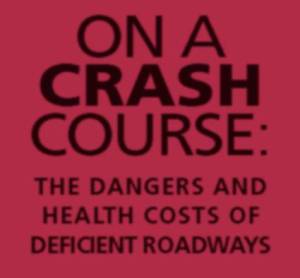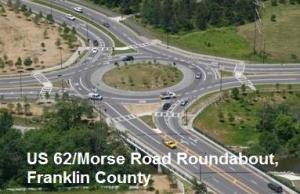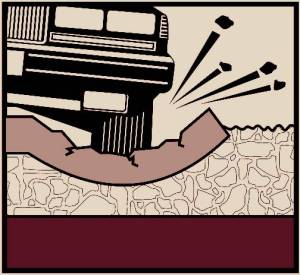Tax-increase avoidance is the motivating factor that will temper everything that happens until that election is over. Meanwhile, we will be faced with the accelerated deterioration of our transportation infrastructure, an increase in national debt and a decrease of highway safety. Throwing $13 to $18 billion in the pot to “pay for the delay” will ultimately cost you and I many times this amount in attempts to catch us up to the rest of the world.
Think about this: you are standing still, sitting in your broken-down, 20-year old jalopy when a new, sleek super-sporty Ferrari screeches by at twice the speed your vehicle was capable of even brand spanking new. You sit and wait 18 minutes before you even attempt to start catching it. What do you think your chances are of catching and passing it?
That’s our commerce in the jalopy and China’s in the Ferrari…
The Transportation Construction Coalition (TCC), co-chaired by the American Road & Transportation Builders Association (ARTBA) and the Associated General Contractors (AGC) of America, includes 28 national associations and labor unions with a direct market interest in the federal transportation programs and focuses on the federal budget and surface transportation program policy issues, released an important study yesterday that you need to read. Before you do, remember millions of Americans will soon take to the roads over the Fourth of July weekend, and even with our depressed economy there will be a lot more people on the roads than normal and the hazards of travel will skyrocket. This new study shows that many may be driving on deficient highways and bridges ripe for safety improvements. With legislation pending for reauthorization of the nation’s transportation funding, TCC members are calling on Congress to provide significant, dedicated funding for roadway safety improvements and to develop programs that encourage states to invest even more.
“The battle on this bill is shaping up on how you fund it,” said Matthew Jeanneret, spokesman for ARTBA. Jeanneret called the report “somewhat groundbreaking.”
“These are tangible things that can be done to save 22,000 lives a year,” he said. “Imagine if a plane with 200 people on board was crashing every three days. Something would be done about it.”
New Study Shows More Forgiving Roads Would Save Lives And Cut Costs; Health Experts & Transportation Leaders Urge Congressional Action
More than half of U.S. highway fatalities are related to deficient roadway conditions – a substantially more lethal factor than drunk driving, speeding or non-use of safety belts according to a landmark study released today. Ten roadway-related crashes occur every minute (5.3 million a year) and also contribute to 38 percent of non-fatal injuries, the report found.
In revealing that deficiencies in the roadway environment contributed to more than 22,000 fatalities and cost the nation more than $217 billion annually, the Pacific Institute for Research and Evaluation (PIRE) concluded that making the roadway environment more protective and forgiving is essential to reducing highway fatalities and costs.
“If we put as much focus on improving road safety conditions as we do in urging people not to drink and drive, we’d save thousands of lives and billions of dollars every year,” principal study author Dr. Ted Miller said. Miller, an internationally-recognized safety economist with PIRE added, “Safer drivers and safer cars remain vitally important, but safer roadways are critical to saving lives, preventing injuries and reducing costs.”
Titled “On a Crash Course: The Dangers and Health Costs of Deficient Roadways,” the study found the $217 billion cost of deficient roadway conditions dwarfs the costs of other safety factors, including: $130 billion for alcohol, $97 billion for speeding, or $60 billion for failing to wear a safety belt. Indeed, the $217 billion figure is more than three-and-one-half times the amount of money government at all levels is investing annually in roadway capital improvements – $59 billion, according to the Federal Highway Administration.
The report concluded that roadway related crashes impose $20 billion in medical costs; $46 billion in productivity costs; $52 billion in property damage and other resource costs; and $99 billion in quality of life costs which measure the value of pain, suffering, and loss of enjoyment of life by those injured or killed in crashes and their families. The report also found that crashes linked to road conditions cost American businesses an estimated $22 billion at a time when many firms are struggling. According to the report, crashes linked to road conditions cost taxpayers over $12 billion every year.
“Recent concerns about swine flu pale in comparison to the number of crash victims I treat,” said Dr. Jared Goldberg, an emergency room physician in Alexandria, VA. “In medical terms, highway fatalities and injuries have reached epidemic proportions, and efforts to prevent further spread of this plague are essential. In the absence of a true vaccine to defend ourselves, fixing dangerous roads would help prevent traffic crashes from occurring in the first place.”
On a Crash Course identifies ways transportation officials can improve road conditions to save lives and reduce injuries. For example, immediate solutions for problem spots include: replacing non-forgiving poles with breakaway poles, using brighter and more durable pavement markings, adding rumble strips to shoulders, mounting more guardrails or safety barriers, and installing better signs with easier-to-read legends. The report also suggested more significant road improvements, including: adding or widening shoulders, improving roadway alignment, replacing or widening narrow bridges, reducing pavement edges and abrupt drop offs, and clearing more space adjacent to roadways.
“Although behavioral factors are involved in most crashes, avoiding those crashes through driver improvement requires reaching millions of individuals and getting them to sustain best safety practices,” continued Miller. “It is far more practical to make the roadway environment more forgiving and protective.”
The report also analyzed crash costs on a state-by-state basis. The 10 states with the:
• Highest total cost from crashes involving deficient road conditions are (alphabetically): Alabama, California, Florida, Georgia, Illinois, New York, North Carolina, Pennsylvania, Tennessee and Texas.
• Highest road-related crash costs per million vehicle miles of travel are: Alabama, Arkansas, Hawaii, Idaho, Kentucky, Louisiana, Mississippi, South Carolina, Tennessee and West Virginia.
• Highest road-related crash costs per mile of road are: California, Connecticut, District of Columbia, Florida, Hawaii, Maryland, Massachusetts, New Jersey, New York and South Carolina.
This is a link to the report with all its details and statistics.
Take the time and read this report. Even if you don’t drive or have a car, your life is tied to the pavements that link every aspect of our lives. Without our transportation system we would not be what we are.
Note: PIRE is a leading independent transportation safety research organization. It has conducted research for a range of organizations, including the National Highway Traffic Safety Administration, Insurance Institute for Highway Safety, National Safety Council and Mothers Against Drunk Driving (MADD). Drawing upon the most recent available data from the U.S. Department of Transportation, PIRE employed analytic modeling methods to evaluate the causes and costs of U.S. motor vehicle crashes in preparing On a Crash Course.
PIRE conducted the study on behalf of the TCC, which hosts the full report, complete state-by-state data and other research findings at http://www.transportationconstructioncoalition.org/.
Greg Sitek

 Drinking water infrastructure in Ohio received a grade of D+. Approximately 90 percent of Ohioans receive water for daily needs from one of the more than 6,000 public water supply systems in the state. An estimated 99 percent of the burden for funding public water supply is borne by the local government agency. ASCE estimates that Ohio has $9.68 billion in drinking water infrastructure needs. The
Drinking water infrastructure in Ohio received a grade of D+. Approximately 90 percent of Ohioans receive water for daily needs from one of the more than 6,000 public water supply systems in the state. An estimated 99 percent of the burden for funding public water supply is borne by the local government agency. ASCE estimates that Ohio has $9.68 billion in drinking water infrastructure needs. The 



 “The federal stimulus program is providing a helpful down payment towards repairing some of the nation’s rough roads,” said Frank Moretti, TRIP’s director of Policy and Research. “But it will take a significant long-term boost in investment by all levels of government to provide Americans with a smooth ride.”
“The federal stimulus program is providing a helpful down payment towards repairing some of the nation’s rough roads,” said Frank Moretti, TRIP’s director of Policy and Research. “But it will take a significant long-term boost in investment by all levels of government to provide Americans with a smooth ride.”
 Soaring construction costs during the past five years are straining state and local budgets. By the summer of 2008, asphalt prices were up 70 percent, concrete 36 percent, and steel 105 percent. Diesel fuel, used to operate heavy construction equipment, soared 305 percent, including a 63 percent jump in one year. Over time, these higher costs have eroded states’ purchasing power on construction projects. In the past few months, however, the economic recession appears to have moderated some of these costs. In fact, many bids for stimulus projects are coming in below engineers’ estimates.
Soaring construction costs during the past five years are straining state and local budgets. By the summer of 2008, asphalt prices were up 70 percent, concrete 36 percent, and steel 105 percent. Diesel fuel, used to operate heavy construction equipment, soared 305 percent, including a 63 percent jump in one year. Over time, these higher costs have eroded states’ purchasing power on construction projects. In the past few months, however, the economic recession appears to have moderated some of these costs. In fact, many bids for stimulus projects are coming in below engineers’ estimates.

